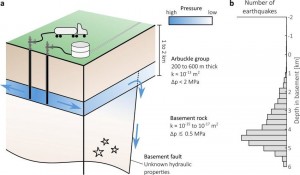From an Article by Megan R. M. Brown, Geophysical Research Letters, June 4, 2018
Descriptive Summary
Studies of the triggering mechanisms of injection‐induced earthquakes have been investigated for decades, but the focus has been on the direct influence of fluid injection in causing fault failure. There have been limited studies into the role of earthquake interactions between the small‐magnitude‐induced seismicity even though there is evidence of earthquake interactions in natural earthquake sequences. In this study, we use models of idealized situations to compare the relative importance of the triggering mechanism of pore pressure change from injection and the triggering mechanism of earthquake interactions. We argue that the small induced earthquakes do matter and that earthquake interactions could have serious implications on the required timing of mitigation action.
Article Abstract
A simplistic triggering mechanism, pore pressure increase from injection, has been the focus of injection‐induced seismicity studies for decades. Research into other possible mechanisms, like poroelastic stress changes, is ongoing, but there has been relatively little focus on earthquake interaction. While studies have looked at how moderate‐magnitude events (M ≥ 3.0) may trigger larger magnitude‐induced seismicity, research into the cumulative effect of the hundreds to thousands of small‐magnitude (M ≤ 3.0) events is lacking. Here we use generic models to compare the possible stress changes from pore pressure increase and from earthquake interactions of small‐magnitude events. We find that the area of increased pore pressure is much larger than that of positive Coulomb static stress transfer; however, maximum Coulomb static stress change is larger than maximum pore pressure increase. We argue that, yes, small earthquakes do matter, and their interaction may be an important triggering mechanism to consider.
*************************************
WEST VIRGINIA UNIVERSITY SEMINAR
WVU Hydrogeoscience Speaker Series
“Mechanisms and Mitigation of Fluid-Induced Earthquakes”
Monday, February 4, 2019, 11:30 a.m. 325 Brooks Hall
WVU Downtown Campus
SPEAKER: Megan R. Brown, Ph.D. Candidate,
Geological Sciences Program
University of Colorado, Boulder, CO
############################
Magnitude 3.6 & 4.2 earthquakes strike northwestern Oklahoma
From Associated Press, Oklahoma Times, January 19, 2019
MENO, Okla. — The U.S. Geological Survey reports moderate earthquakes in northwestern Oklahoma recently.
The U.S.G.S. recorded magnitude 3.6 and 4.2 quakes in Major County near the town of Meno, about 75 miles northwest of Oklahoma City and others regionally.
Thousands of earthquakes recorded in Oklahoma in recent years have been linked to the underground injection of wastewater from oil and gas production. There have been over 2700 of these earthquakes since 2010.
Geologists say about 200 quakes of magnitude 3.0 or stronger were recorded in Oklahoma last year, down from 302 in 2017 and the third consecutive year of declines since regulators began directing producers to close some wells and reduce injection volumes in others.

